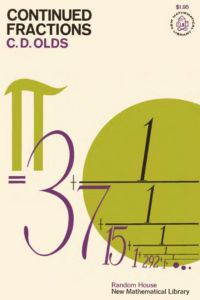In Collection
#1871
Read It:
Yes
#1871
Read It:
Yes
|
|
||||||||||
Notes
Continued fractions are an area of mathematics that I have paid little attention to over my career. I have encountered and solved an occasional journal problem using continued fractions and worked with them a little bit in a number theory class that I took. However, I have yet to use them in any way in any of the classes that I have taught.
When I saw this book in the library, I was intrigued, because this is an area within the bounds of undergraduate capability. After reading it, I am very glad that I picked it off the shelf. In less than two hundred pages, I made up for years of neglect. Starting at the beginning, where rational numbers are expanded out as a continued fraction, Olds sets the table for the real points of interest, which are solving Diophantine equations and expressing an irrational number as a continued fraction. The construction of continued fractions is so simple and easy to understand that I can see many ways in which they can be used to illustrate continued operations. For example, recursion is regularly taught in Discrete Mathematics courses aimed at computer science majors. Using the operation of an infinite continued fraction is yet another way to illustrate the basic principles of a recursive definition.
The problems solved in the text are solid demonstrations of the utility of continued fractions, proving that they are yet another way to solve some classes of problems. Until I went through this book, I was unaware of some of the uses of continued fractions and the wide range of problems where they can be used. Problems for solution are given in each section and solutions to all are included at the end of the book.
This is an excellent primer of a subject that should be given more time in the undergraduate curriculum. Continued fractions require a thought process that is different from many others, yet do not require sophisticated mathematics. Generally speaking, the more different types of mathematical thinking that undergraduates do, the better they become. I will try to incorporate more continued fractions into my teaching in the future.
When I saw this book in the library, I was intrigued, because this is an area within the bounds of undergraduate capability. After reading it, I am very glad that I picked it off the shelf. In less than two hundred pages, I made up for years of neglect. Starting at the beginning, where rational numbers are expanded out as a continued fraction, Olds sets the table for the real points of interest, which are solving Diophantine equations and expressing an irrational number as a continued fraction. The construction of continued fractions is so simple and easy to understand that I can see many ways in which they can be used to illustrate continued operations. For example, recursion is regularly taught in Discrete Mathematics courses aimed at computer science majors. Using the operation of an infinite continued fraction is yet another way to illustrate the basic principles of a recursive definition.
The problems solved in the text are solid demonstrations of the utility of continued fractions, proving that they are yet another way to solve some classes of problems. Until I went through this book, I was unaware of some of the uses of continued fractions and the wide range of problems where they can be used. Problems for solution are given in each section and solutions to all are included at the end of the book.
This is an excellent primer of a subject that should be given more time in the undergraduate curriculum. Continued fractions require a thought process that is different from many others, yet do not require sophisticated mathematics. Generally speaking, the more different types of mathematical thinking that undergraduates do, the better they become. I will try to incorporate more continued fractions into my teaching in the future.
